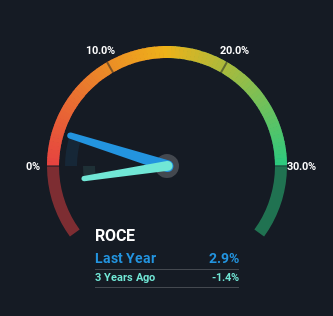Hoden Seimitsu Kako Kenkyusho (TSE:6469) Could Be Struggling To Allocate Capital

What underlying fundamental trends can indicate that a company might be in decline? A business that's potentially in decline often shows two trends, a return on capital employed (ROCE) that's declining, and a base of capital employed that's also declining. This indicates the company is producing less profit from its investments and its total assets are decreasing. So after we looked into Hoden Seimitsu Kako Kenkyusho (TSE:6469), the trends above didn't look too great.
Understanding Return On Capital Employed (ROCE)
For those who don't know, ROCE is a measure of a company's yearly pre-tax profit (its return), relative to the capital employed in the business. The formula for this calculation on Hoden Seimitsu Kako Kenkyusho is:
Return on Capital Employed = Earnings Before Interest and Tax (EBIT) ÷ (Total Assets - Current Liabilities)
0.029 = JP¥327m ÷ (JP¥17b - JP¥5.5b) (Based on the trailing twelve months to May 2024).
Therefore, Hoden Seimitsu Kako Kenkyusho has an ROCE of 2.9%. In absolute terms, that's a low return and it also under-performs the Machinery industry average of 7.9%.
See our latest analysis for Hoden Seimitsu Kako Kenkyusho

While the past is not representative of the future, it can be helpful to know how a company has performed historically, which is why we have this chart above. If you'd like to look at how Hoden Seimitsu Kako Kenkyusho has performed in the past in other metrics, you can view this free graph of Hoden Seimitsu Kako Kenkyusho's past earnings, revenue and cash flow.
What Can We Tell From Hoden Seimitsu Kako Kenkyusho's ROCE Trend?
There is reason to be cautious about Hoden Seimitsu Kako Kenkyusho, given the returns are trending downwards. To be more specific, the ROCE was 6.0% five years ago, but since then it has dropped noticeably. And on the capital employed front, the business is utilizing roughly the same amount of capital as it was back then. Companies that exhibit these attributes tend to not be shrinking, but they can be mature and facing pressure on their margins from competition. If these trends continue, we wouldn't expect Hoden Seimitsu Kako Kenkyusho to turn into a multi-bagger.
What We Can Learn From Hoden Seimitsu Kako Kenkyusho's ROCE
In summary, it's unfortunate that Hoden Seimitsu Kako Kenkyusho is generating lower returns from the same amount of capital. However the stock has delivered a 62% return to shareholders over the last five years, so investors might be expecting the trends to turn around. In any case, the current underlying trends don't bode well for long term performance so unless they reverse, we'd start looking elsewhere.
Since virtually every company faces some risks, it's worth knowing what they are, and we've spotted 3 warning signs for Hoden Seimitsu Kako Kenkyusho (of which 1 shouldn't be ignored!) that you should know about.
If you want to search for solid companies with great earnings, check out this free list of companies with good balance sheets and impressive returns on equity.
If you're looking to trade Hoden Seimitsu Kako Kenkyusho, open an account with the lowest-cost platform trusted by professionals, Interactive Brokers.
With clients in over 200 countries and territories, and access to 160 markets, IBKR lets you trade stocks, options, futures, forex, bonds and funds from a single integrated account.
Enjoy no hidden fees, no account minimums, and FX conversion rates as low as 0.03%, far better than what most brokers offer.
Sponsored ContentValuation is complex, but we're here to simplify it.
Discover if Hoden Seimitsu Kako Kenkyusho might be undervalued or overvalued with our detailed analysis, featuring fair value estimates, potential risks, dividends, insider trades, and its financial condition.
Access Free AnalysisHave feedback on this article? Concerned about the content? Get in touch with us directly. Alternatively, email editorial-team (at) simplywallst.com.
This article by Simply Wall St is general in nature. We provide commentary based on historical data and analyst forecasts only using an unbiased methodology and our articles are not intended to be financial advice. It does not constitute a recommendation to buy or sell any stock, and does not take account of your objectives, or your financial situation. We aim to bring you long-term focused analysis driven by fundamental data. Note that our analysis may not factor in the latest price-sensitive company announcements or qualitative material. Simply Wall St has no position in any stocks mentioned.
About TSE:6469
Hoden Seimitsu Kako Kenkyusho
Manufactures and sells electric discharge machining, industrial gas turbine parts, and other metal products.
Solid track record with excellent balance sheet.
Market Insights
Community Narratives


